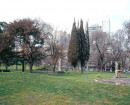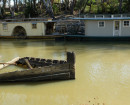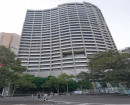POWDER MAGAZINE
SKIDMORE ROAD BEECHWORTH, INDIGO SHIRE
-
Add to tour
You must log in to do that.
-
Share
-
Shortlist place
You must log in to do that.
- Download report



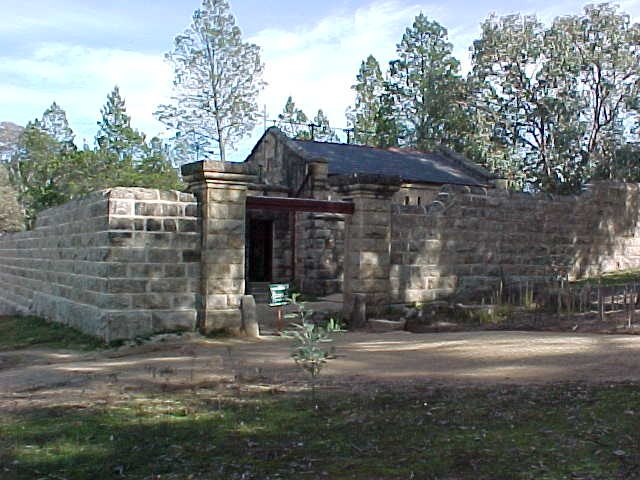

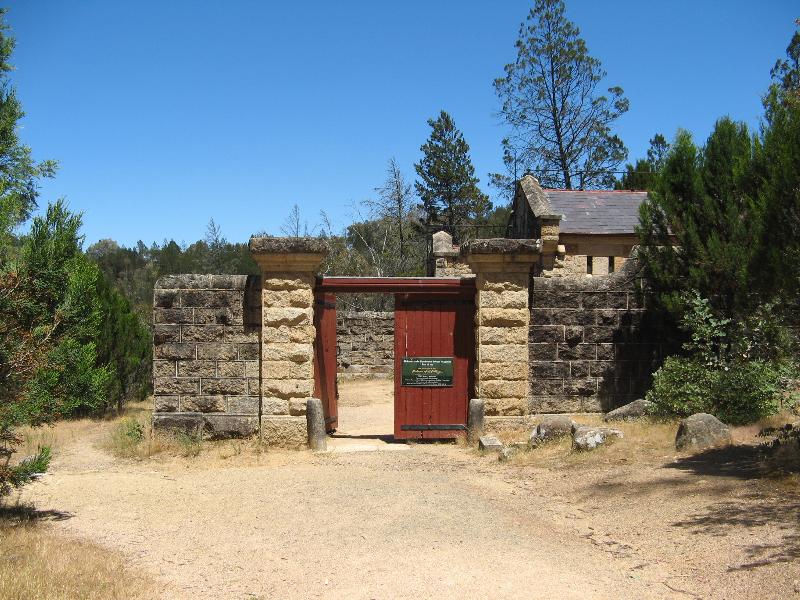


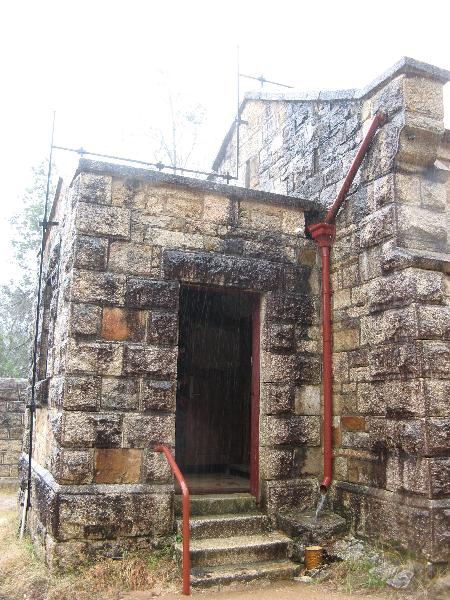

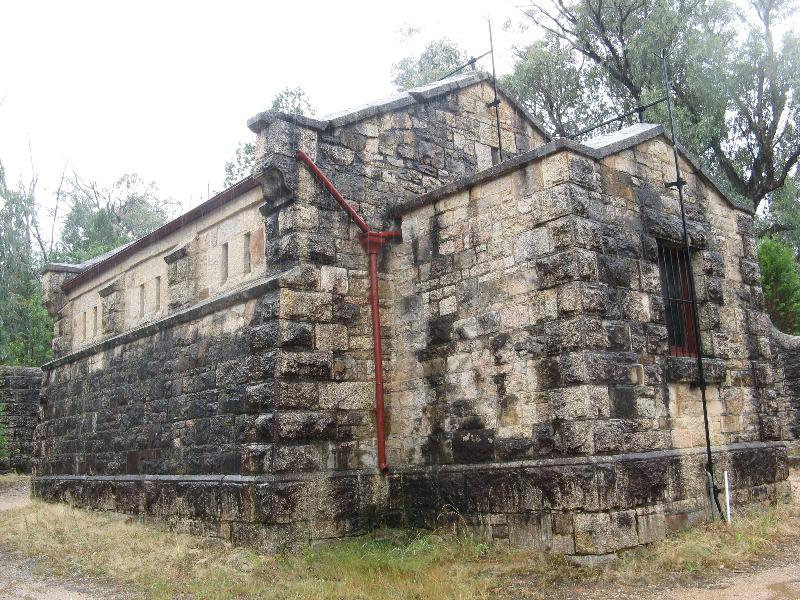
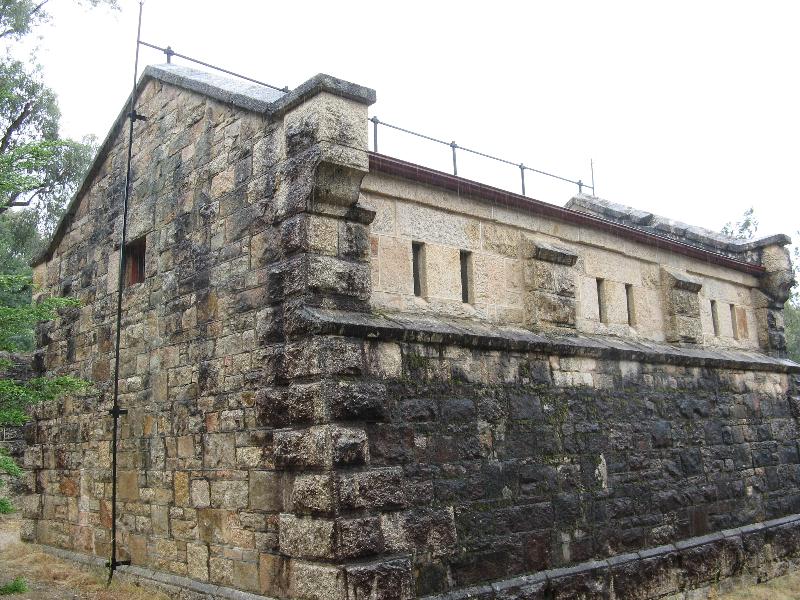
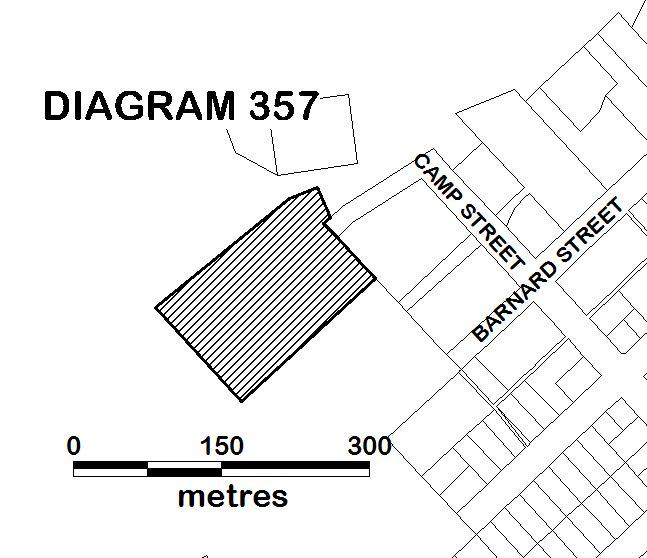
Statement of Significance
What is significant?
The Powder Magazine at Beechworth, including the stone magazine built in 1859 and the surrounding walls built in 1860.
History Summary
The Powder Magazine at Beechworth was constructed in 1859 by the Melbourne builders, T Dawson and Company to designs by the Public Works Department. The boundary walls were completed the following year by another Melbourne firm, Atchison & Lumsden. This was one of several government magazines built on the Victorian goldfields at the end of the 1850s for the safe storage of gunpowder. The need for the magazines resulted from the exhaustion of surface gold deposits in Victoria and the subsequent change to the mining of deep alluvial and quartz deposits, which required the use of large amounts of gunpowder for blasting. Storage facilities were needed close to the mines but at a safe distance from habitation. In 1857 the Victorian government legislated to control the storage of gunpowder, and provide for the establishment of public powder magazines to be financed by Treasury and administered locally. The Beechworth Powder Magazine was opened for use by the local gold miners in 1860. It was obsolete by the early 1900s, as local gold mining decreased and nitro-glycerine compounds such as gelignite came into use. It was closed in 1918 and its condition deteriorated during the following decades. It was restored in 1963-66 by the National Trust of Australia (Victoria), and in 1966 became the first of their properties to be opened to the public outside the Melbourne metropolitan area.
Description Summary
The Powder Magazine stands in a bush setting to the west of the town of Beechworth, and is separated from it by a deep gorge. It is a small rectangular-plan building with massive stone walls of local granite and a slate roof, and has a small entrance porch at one end. It has parapeted gable ends, and along the side walls are small buttresses and slit openings for ventilation. The building has an elaborate system of lightning conductors running along the roof ridge and down the end walls. The arched inner roof and double arched foundations were designed such that if an explosion did occur, the force of the blast would be directed upwards. The magazine building is enclosed by a granite wall with massive entry pillars and a timber gate.
How is it significant?
The Powder Magazine at Beechworth is of architectural and historical significance to the State of Victoria. It satisfies the following criteria for inclusion in the Victorian Heritage Register:
Criterion A
Importance to the course, or pattern, of Victoria's cultural history.
Criterion D
Importance in demonstrating the principal characteristics of a class of cultural places and objects.
Why is it significant?
The Powder Magazine at Beechworth is significant at the State level for the following reasons:
The Powder Magazine at Beechworth is historically significant for its association with the history of gold mining in Victoria. It is associated with the change from alluvial to deep mining of gold in the late 1850s, as the easily extracted surface gold deposits were depleted. Deep mining required large amounts of gunpowder for blasting away the rock overlying the gold deposits, and the magazines were constructed by the Victorian Government to safely store the gunpowder required for this. [Criterion A]
The Powder Magazine at Beechworth is architecturally significant as an outstanding and intact example of the powder magazines constructed by the Victorian Government in the late 1850s in the gold mining regions of Victoria. It demonstrates the characteristic features of these structures, being designed for the storage of black powder. These had massive walls and light-weight roofs, so that if an accidental explosion occurred, the force of the blast would be directed upwards, thus minimising the risk of damage in the surrounding area. [Criterion D]
The Powder Magazine at Beechworth is also significant for the following reasons, but not at the State level:
The Powder Magazine at Beechworth is significant for its close association with the gold-mining history of Beechworth. Together with other government buildings constructed in the town from 1857-60, the powder magazine and its surrounding walls are built of local granite, and are a distinctive element of this historic town.
-
-
POWDER MAGAZINE - History
Contextual history
Beechworth owes its existence to the discovery of gold in 1852. The Beechworth area was first settled by squatters from 1837, but the discovery of gold resulted in a rush of miners to the area, with about 8,000 arriving by November that year. The Ovens was an important river system in north-east Victoria and gave its name to the goldfields in this area. The town developed around the Gold Commissioner's Camp, established in 1852 on the granite hill on the north bank of Spring Creek. The township was first known as Mayday Hills, but when surveyed in 1853, it was named Beechworth. The main overland route between Melbourne and Sydney passed through the town until the 1870s (when the railway was built further to the west), and until then Beechworth was one of the richest towns in Victoria and the financial and administrative centre of the north-east.
Until the mid-1850s most buildings in the town were constructed of wood, bark or canvas, but following the election of a town council in 1856 stricter building regulations were introduced. Many of the town's major buildings were erected during the following five years, including the Ovens District Hospital (1856, VHR H358) and the Burke Museum (VHR H345, begun in 1857 by the Young Men's Association as a hall and library). The first town hall was built in 1859. By the early 1860s a group of important administrative buildings, known as the Beechworth Justice Precinct (VHR H1464), had been completed along the south side of Ford Street, and a large gaol (VHR H1549) was begun to the north of this in 1858. The Beechworth Lunatic Asylum, later the Mayday Hills Hospital (VHR H1864-67) was built in 1864-67, and the landmark post office (VHR H867) was completed in 1870.
The Ovens gold rushes peaked in 1857, and during the following two decades the population of Beechworth decreased (though the last mining company in the district only closed in 1956). Despite the decline in the gold industry, the town was sustained well into the twentieth century by the presence of the government institutions founded in the 1850s and 1860s: the asylum and the gaol.
Tourism has now become a major industry in Beechworth. Tourism began in the 1880s with the town's reputation as a health resort and picturesque beauty spot. The declining prosperity of the town had the advantage that the post-World War II development, that led to the destruction of so much of Victoria's nineteenth century fabric between the 1950s and 1970s, was avoided. At this time there was an increasing awareness of the importance of Victoria's early history and heritage. In the 1960s the National Trust was active in classifying Beechworth's early buildings, and efforts began to restore buildings which had fallen into disrepair. The retention of much of the town's historic character has now made it a popular tourist destination.
History of place
Beechworth's Powder Magazine was one of several government magazines built on the Victorian goldfields towards the end of the 1850s to store and provide weather protection for gunpowder. Surface alluvial mining was at this time changing to deeper alluvial and quartz mining, and large amounts of gunpowder were needed for blasting away the rock to reach the gold. This in turn created a demand for storage facilities for the gunpowder, close to the mines but at a safe distance from settlements. The Victorian Government in 1857 legislated to regulate the storage of gunpowder, which provided for the establishment of public powder magazines to be financed by the Treasury and administered locally. Miners were required by law to store bulk gunpowder here until needed.
In February 1858 the Beechworth Council requested that the government build a powder magazine at Beechworth. The site chosen was on the outskirts of the town above the gorge. The magazine was built to plans by the Victorian Department of Public Works, originally designed for Portland (but never built). It was to be built of local granite in the style of early colonial military buildings, with restrained classical influences. In 1859 the Melbourne builders T Dawson & Co constructed the magazine at a cost of £697.7.0. In the following year another Melbourne firm, Atchison & Lumsden, built the boundary wall at a cost of £807.13.0. The magazine was opened for use by the miners on 1 September 1860, when the first keeper took up his duties.
Strict precautions were taken to minimise the risk of explosions. The surrounding area was cleared in case of bush fires. The magazine had an elaborate system of lightning conductors, all metal fittings were made of copper to eliminate the possibility of sparks, and people entering the magazine wore special clothing and footwear. No vehicles or animals were allowed within the boundary walls of the magazine. The magazine was designed with an arched inner roof and double-arched foundations so that if an explosion were to occur, the force of the blast would go upwards rather than outwards, thus minimising damage to the surroundings.
By the late nineteenth century, gold mining in Beechworth had petered out and nitro-glycerine compounds, such as gelignite had come into use. The building became largely obsolete, as the small amount of gunpowder required was more conveniently stored in smaller private magazines. The same was true for other magazines in Victoria, but their closure was delayed because of their potential military value. The Beechworth magazine, and four other government magazines, finally closed on 31 March 1918.
The magazine was neglected and its condition deteriorated. In the 1930s Depression it became a favourite stopping place for the unemployed, and was known as 'the Menzies [a landmark Melbourne hotel, demolished in 1969] of the north-east'. To prevent people sleeping in the building the Shire Council collapsed the roof, which led to the rapid decline of the structure. By the 1960s there were plans to demolish it. However moves had begun by local residents, led by Jack Skidmore, for its preservation, and in 1963 Frank Strahan (the University of Melbourne archivist and a member of the National Trust's classification committee), Dr Alan Beever (a lecturer in economic history), and other interested Melbourne people, formed working parties at the magazine. In 1965 the restoration was taken over officially by the National Trust, which had become closely involved with the conservation of the town of Beechworth. The Powder Magazine became the first National Trust property to be opened to the public outside Melbourne in April 1966.
KEY REFERENCES USED TO PREPARE ASSESSMENT
National Trust of Australia (Victoria), Beechworth and the Powder Magazine, 1970.Carole Woods, Beechworth. A Titan's Field, North Melbourne 1985.
POWDER MAGAZINE - Plaque Citation
This is an outstanding example of the powder magazines built on the goldfields by the Victorian Government in the late 1850s for the safe storage of gunpowder. It opened in 1860, closed in 1918, and was restored by the National Trust in 1963-66.
POWDER MAGAZINE - Permit Exemptions
General Exemptions:General exemptions apply to all places and objects included in the Victorian Heritage Register (VHR). General exemptions have been designed to allow everyday activities, maintenance and changes to your property, which don’t harm its cultural heritage significance, to proceed without the need to obtain approvals under the Heritage Act 2017.Places of worship: In some circumstances, you can alter a place of worship to accommodate religious practices without a permit, but you must notify the Executive Director of Heritage Victoria before you start the works or activities at least 20 business days before the works or activities are to commence.Subdivision/consolidation: Permit exemptions exist for some subdivisions and consolidations. If the subdivision or consolidation is in accordance with a planning permit granted under Part 4 of the Planning and Environment Act 1987 and the application for the planning permit was referred to the Executive Director of Heritage Victoria as a determining referral authority, a permit is not required.Specific exemptions may also apply to your registered place or object. If applicable, these are listed below. Specific exemptions are tailored to the conservation and management needs of an individual registered place or object and set out works and activities that are exempt from the requirements of a permit. Specific exemptions prevail if they conflict with general exemptions. Find out more about heritage permit exemptions here.Specific Exemptions:General Condition 1
All exempted alterations are to be planned and carried out in a manner which prevents damage to the fabric of the registered place or object.
General Condition 2
Should it become apparent during further inspection or the carrying out of works that original or previously hidden or inaccessible details of the place or object are revealed which relate to the significance of the place or object, then the exemption covering such works shall cease and Heritage Victoria shall be notified as soon as possible.
General Condition 3
All works should be informed by Conservation Management Plans prepared for the place. The Executive Director is not bound by any Conservation Management Plan, and permits still must be obtained for works suggested in any Conservation Management Plan.
General Condition 4
Nothing in this determination prevents the Heritage Council from amending or rescinding all or any of the permit exemptions.
General Condition 5
Nothing in this determination exempts owners or their agents from the responsibility to seek relevant planning or building permits from the relevant responsible authority, where applicable.
SPECIFIC PERMIT EXEMPTIONS
Magazine and walls:
. Minor repairs and maintenance which replace like with like.
. Installation or repair of damp-proofing by either injection method or grouted pocket method in a manner which does not affect the cultural heritage significance of the place.
. Repair or removal of modern display cases.
Hard landscape elements:
. Repair and maintenance of roads and pathways which replace like with like.
. Removal of roads and pathways that are not part of the original design.
Bushland:
. All maintenance of bushland.
. Fire management works carried out to protect the magazine and walls.
POWDER MAGAZINE - Permit Exemption Policy
Preamble
The purpose of the Permit Policy is to assist when considering or making decisions regarding works to a registered place. It is recommended that any proposed works be discussed with an officer of Heritage Victoria prior to making a permit application. Discussing proposed works will assist in answering questions the owner may have and aid any decisions regarding works to the place.
The extent of registration of the Powder Magazine at Beechworth on the Victorian Heritage Register affects the whole place shown on Diagram 357 including the land, all buildings, roads, trees, landscape elements and other features. Under the Heritage Act 1995 a person must not remove or demolish, damage or despoil, develop or alter or excavate, relocate or disturb the position of any part of a registered place or object without approval. It is acknowledged, however, that alterations and other works may be required to keep places and objects in good repair and adapt them for use into the future.
If a person wishes to undertake works or activities in relation to a registered place or registered object, they must apply to the Executive Director, Heritage Victoria for a permit. The purpose of a permit is to enable appropriate change to a place and to effectively manage adverse impacts on the cultural heritage significance of a place as a consequence of change. If an owner is uncertain whether a heritage permit is required, it is recommended that Heritage Victoria be contacted.
Permits are required for anything which alters the place or object, unless a permit exemption is granted. Permit exemptions usually cover routine maintenance and upkeep issues faced by owners as well as minor works. They may include appropriate works that are specified in a conservation management plan. Permit exemptions can be granted at the time of registration (under s.42 of the Heritage Act) or after registration (under s.66 of the Heritage Act).
It should be noted that the addition of new buildings to the registered place, as well as alterations to the interior and exterior of existing buildings requires a permit, unless a specific permit exemption is granted.
Cultural heritage management plans
It is recommended that a Conservation Management Plan is developed to manage the place in a manner which respects its cultural heritage significance.
Cultural heritage significance
Overview of significance
The cultural heritage significance of the Powder Magazine at Beechworth lies in it being an outstanding and intact example of the powder magazines constructed by the Victorian Government in the late 1850s in the gold mining regions of Victoria. It demonstrates the characteristic features of these structures designed for the storage of black powder. These had massive walls and light-weight roofs, so that if an accidental explosion occurred, the force of the blast would be directed upwards, thus minimising the risk of damage in the surrounding area.
a) All of the buildings and features listed here are of primary cultural heritage significance in the context of the place. A permit is required for most works or alterations. See Permit Exemptions section for specific permit exempt activities:
. The Powder Magazine
. The walls surrounding the Magazine
b) The bush surrounding the magazine walls, the road and the carpark are of no cultural heritage significance. Specific permit exemptions are provided for these.
Archaeological: Ground disturbance may affect the archaeological significance of the place and, subject to the exemptions stated in this document, requires a permit.
-
-
-
-
-
FORMER BANK OF VICTORIA
 Victorian Heritage Register H0348
Victorian Heritage Register H0348 -
LONDON TAVERN
 Victorian Heritage Register H0350
Victorian Heritage Register H0350 -
FORMER OVENS DISTRICT HOSPITAL
 Victorian Heritage Register H0358
Victorian Heritage Register H0358
-
'Altona' Homestead (Formerly 'Laverton' Homestead) and Logan Reserve
 Hobsons Bay City
Hobsons Bay City
-
-






